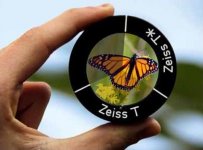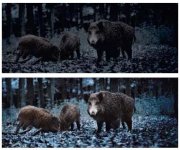Although a high quality 8x42 pair of binoculars has the same sized exit pupil as any other 8x42, an observer will notice a significant difference in twilight at dawn and dusk when using the high-quality binoculars. Why is this so?
The difference lies in the transmission of light through the binoculars, and a high quality 8x42 such as the Zeiss Victory SF simply allows more light to reach the eyes of the observer than some other models. The transmission is measured at the eyepiece, and the percentage figure used to express this, is the percentage of the light that entered the binoculars through the objective lenses and emerged from the eyepiece as the exit pupil. The different impacts that the exit pupil and transmission values have may be described in this way: the exit pupil can be likened to the size of a window and the transmission value can be likened to the cleanliness and transparency of the window. So, although you may think two 8x42 binoculars with the same sized exit pupil will have the same brightness, it is the one with the highest transmission that will be the brightest and most effective in dark observing conditions such as under heavy cloud or in the twilight of dawn or dusk.

The ZEISS Vergütungsdemonstrator shows the following:
Top left: uncoated glass with 50% light transmission.
Below: Simple Glass (T) with 80% light transmission.
Top right: multi-coated glass (T*) with more than 90% light transmission.
The best quality binoculars provide transmission values over 90%; measurements of the ZEISS Victory SF 8x42 showed a minimum value of 92%. In practice, differences of 1 to 2% are not noticeable, but a 4-5% increase provides a decisive advantage in dwindling light.
Around the world, binoculars from ZEISS command a high respect for their performance in difficult lighting situations. This is closely linked to the T* coating which has become synonymous with maximum light transmission and the brightest images.
Initial tests conducted at Carl Zeiss Jena by Alexander Smakula resulted in a method of applying a transmission coating to glass and led to Zeiss registering a patent in 1935. This is when the famous T coating – a single coat, with no ‘star’ after the T – was born. It was replaced by the T* multi-coating at the end of the 1970s. The current ZEISS T* multi-coating on all glass-air surfaces is not simply a fixed recipe, but is an innovative multi-coat procedure that is constantly under development, with a typical six-coat structure that is individually matched to each lens and type of glass. Therefore it is normal for each optical tube of Zeiss binoculars to contain more than 100 layers that were applied to the lenses by a technique of evaporation in high-vacuum chambers.
In addition to increasing transmission, the coating also serves as an effective, hard surface sealant that protects the optical glass.
Transmission measurement is relatively difficult, which is why the values rarely appear in reviews. The transmission values for spectral colours (different wavelengths) are determined individually by means of nearly 500 measurements. The result is assessed in relation to the sensitivity of the human eye regarding the different colours (sensitivity curve). The eye is most sensitive to the green spectral range. Accordingly, these colours have the greatest influence. High infrared or Ultra-Violet wavelengths are not included in the assessment because they are not perceived by the eye. The final result is a value known as day transmission.
While the cones in the retina are primarily responsible for daytime vision, it is the rods that take over at night or in very low light. This results in a different sensitivity curve regarding colours: the maximum sensitivity moves to the blue spectrum. If the measured spectral transmission curve is assessed using this night sensitivity now it provides the night transmission.
Night or day makes no difference to the binoculars but to the sensitivity of the eye. The T* coating takes into account the different sensitivities of the human eye in daylight and in twilight to optimise light transmission at all times.
The difference lies in the transmission of light through the binoculars, and a high quality 8x42 such as the Zeiss Victory SF simply allows more light to reach the eyes of the observer than some other models. The transmission is measured at the eyepiece, and the percentage figure used to express this, is the percentage of the light that entered the binoculars through the objective lenses and emerged from the eyepiece as the exit pupil. The different impacts that the exit pupil and transmission values have may be described in this way: the exit pupil can be likened to the size of a window and the transmission value can be likened to the cleanliness and transparency of the window. So, although you may think two 8x42 binoculars with the same sized exit pupil will have the same brightness, it is the one with the highest transmission that will be the brightest and most effective in dark observing conditions such as under heavy cloud or in the twilight of dawn or dusk.

The ZEISS Vergütungsdemonstrator shows the following:
Top left: uncoated glass with 50% light transmission.
Below: Simple Glass (T) with 80% light transmission.
Top right: multi-coated glass (T*) with more than 90% light transmission.
The best quality binoculars provide transmission values over 90%; measurements of the ZEISS Victory SF 8x42 showed a minimum value of 92%. In practice, differences of 1 to 2% are not noticeable, but a 4-5% increase provides a decisive advantage in dwindling light.
Around the world, binoculars from ZEISS command a high respect for their performance in difficult lighting situations. This is closely linked to the T* coating which has become synonymous with maximum light transmission and the brightest images.
Background:
A variety of factors, including the reflection of light entering and passing through the binoculars, can result in a loss of light. Because a small portion of light is reflected every time the light passes from air to glass (and vice versa), anti-reflection coatings on the glass surfaces can have a huge impact on improving this. Without an effective coating, this loss would be about 4% for each glass surface, and over 6% on some of the glasses used that have large refractive indexes. High-quality ZEISS binoculars include up to 12 lens elements or more, plus two prisms, on each side. Depending on the number of cemented elements, 16 to 20 glass-air surfaces may be used. Without an effective coating, the transmission would be considerably less than 50% and the images would be dull and lack contrast, making the perception of details difficult or impossible.Initial tests conducted at Carl Zeiss Jena by Alexander Smakula resulted in a method of applying a transmission coating to glass and led to Zeiss registering a patent in 1935. This is when the famous T coating – a single coat, with no ‘star’ after the T – was born. It was replaced by the T* multi-coating at the end of the 1970s. The current ZEISS T* multi-coating on all glass-air surfaces is not simply a fixed recipe, but is an innovative multi-coat procedure that is constantly under development, with a typical six-coat structure that is individually matched to each lens and type of glass. Therefore it is normal for each optical tube of Zeiss binoculars to contain more than 100 layers that were applied to the lenses by a technique of evaporation in high-vacuum chambers.
In addition to increasing transmission, the coating also serves as an effective, hard surface sealant that protects the optical glass.
Transmission measurement is relatively difficult, which is why the values rarely appear in reviews. The transmission values for spectral colours (different wavelengths) are determined individually by means of nearly 500 measurements. The result is assessed in relation to the sensitivity of the human eye regarding the different colours (sensitivity curve). The eye is most sensitive to the green spectral range. Accordingly, these colours have the greatest influence. High infrared or Ultra-Violet wavelengths are not included in the assessment because they are not perceived by the eye. The final result is a value known as day transmission.
While the cones in the retina are primarily responsible for daytime vision, it is the rods that take over at night or in very low light. This results in a different sensitivity curve regarding colours: the maximum sensitivity moves to the blue spectrum. If the measured spectral transmission curve is assessed using this night sensitivity now it provides the night transmission.
Night or day makes no difference to the binoculars but to the sensitivity of the eye. The T* coating takes into account the different sensitivities of the human eye in daylight and in twilight to optimise light transmission at all times.






